Transcript of "The Ancient Israelites"
- 1. The First Israelites Chapter Three, Section One
- 2. About 1200 BC, great changes took place around Mediterranean ◦ Empires fell and new people entered the region 1000 BC, Israelites built a kingdom in Canaan Canaan lies along the Mediterranean Sea in Middle East.
- 3. Small population of people. Israelites believed in God—only one; monotheism Israelite faith become Judaism; known as Jews ◦ Influenced Christianity and Islam ◦ Shaped beliefs and practices of societies in Europe and Americas. Spoke Hebrew; wrote their beliefs in the Hebrew Bible Came from Mesopotamia-herders and traders; settled in Canaan
- 4. Abraham—father of the Hebrews. Believe God told Abraham to go to Canaan. God promised the land to Abraham and the Hebrews. Jacob—grandson of Abraham; also called Israel ◦ Had 12 sons; Divided his family into 12 tribes. 12 Tribes of Israel Lived in Israel for 100 years; moved to Egypt to escape famine
- 5. While in Egypt they were enslaved by Pharaoh. They were subject to infanticide— murder of their infants Moses led his people out of Egypt; 10 plagues on Egyptians Ten Commandments—at top of Mt. Sinai, received the laws from God. The commandments were an important part of the Torah; most important in shaping moral laws of many nations. Torah—first part of the Hebrew Bible; describes a covenant
- 6. Took 40 years to reach Canaan; Moses had already died Joshua took over leadership after Moses; brought Israelites to Canaan Canaanites were living there when they arrived. Joshua and his army took the city of Jericho and other lands in three wars. ◦ The territories were divided among the 12 Tribes of Israel
- 7. Judge—An Israelite military leader that guided the 12 tribes after Joshua’s death. Usually they guided 1 or 2 tribes; Deborah—only known woman judge. ◦ 1125 BC—Deborah and her troops destroyed King Jabin and his army of Canaanites. Over time, the judges gained control over all the hilly regions of Canaan. The Canaanites only controlled the coastal areas.
- 8. Led by Abraham, the Israelites settled in Canaan. They later moved to Egypt and were enslaved, but then escaped. The Israelites used the Ten Commandments as rules to live by. Joshua and the judges, including Deborah, won back territory in central Canaan for the Israelites.
- 9. Kingdom of Israel Chapter 3; Section 2
- 10. Israelites Choose a King 1000 BC— Philistines strongest in the region of Canaan Israelites believe they need to choose a king to unite the tribes and become stronger
- 11. Rule of King Saul 1020 BC— Israelites asked Samuel to choose a king. Samuel—a judge and prophet Samuel selects Saul a warrior and farmer; first king of Israel Hebrew Bible says Saul lost favor with God and the people
- 12. King David David—was in charge of Saul’s army; known for his bravery and leadership; David and Goliath 1000 BC—David takes the throne of Israel David as King ◦ Drove Philistines from the region ◦ Created an Empire ◦ Conquered nations paid a tribute—added to Israel’s wealth
- 13. King David ◦ Taxes the Israelites heavily Wanted to expand Jerusalem Wanted to build a temple for the Jews in Jerusalem
- 14. King Solomon Solomon—last king of a united Israel; noted for his wisdom, but hated for his taxation ◦ Built the great stone temple in Jerusalem Becomes a symbol and center of Jewish religion ◦ Known for his proverbs— wise sayings ◦ 1000-922 BC—the period of kings.
- 15. After Solomon When Solomon died, Northerners rebelled ◦ 10 of the 12 tribes set up their own nation in the north—Kingdom of Israel (922 BC) ◦ Samaria—capital of Kingdom of Israel. Kingdom of Judah ◦ Two tribes ◦ Jerusalem remained the Capital
- 16. Fall of Israel ◦ 722 BC—Assyrians conquered Israel and scattered 10 tribes across their empire. ◦ They are known as the “Lost Tribes of Israel”
- 17. Fall of Judah ◦ 620 BC—Egyptians conquered the Kingdom of Judah Israelites kept their king but paid tribute to Egypt ◦ 605 BC—Chaldeans conquer Egypt; Egyptians and Jews unite but fail ◦ 597 BC—Nebuchadnezzar captures Jerusalem Punished Jews severely—10,000 forced to leave and live in Babylon A second rebellion was crushed and the Temple was destroyed. Time in Babylon called the Babylonian Exile—597-538 BC ◦ 538 BC—Persian king Cyrus allows Jews to rebuild Jerusalem
- 18. Review the Main Ideas Saul was the first king of the Israelites. He united the 12 tribes into one kingdom. King David built an Israelite empire and made Jerusalem his capital. Solomon built a great temple at Jerusalem, but after he died, the Israelites split into two kingdoms—Israel and Judah The Assyrians and then the Chaldeans conquered Israel and Judah, and forced many Israelites to leave their homeland.
- 19. Growth of Judaism Chapter three, section three
- 20. Exile and Return During the exile (586-538 BC) in Babylon the Israelite religion became what we call Judaism Sabbath—small groups of Jews would meet for a day of worship and rest at the synagogues 538 BC—Cyrus allowed the Jews to return to Judah; some stayed in Babylon, many went home They rebuilt Jerusalem and the temple. Were not allowed to have their own king Religious leaders ran their society Scribes became religious scholars Ezra—wrote five books of the Torah on pieces of parchment— scrolls; Torah and writings added later made up the Hebrew Bible.
- 21. Jews Look to the Future Story of Daniel reminded Jews that God would rescue them Daniel was important to the Chaldean rulers but he refused to worship Babylonian gods. They threw him into the Lion’s den but God protected Daniel from the Lions. Jews believed that evil and suffering would
- 22. Jews and the Greeks 331 BC, Alexander the Great (Greek) defeated Persians so Judah came under his control Jews were allowed to stay in Judah; Hebrews were introduced Greek language and culture Jews were living throughout Alexander’s empire at this time; This became known as diaspora During diaspora, Jews learned Greek ways and copied the
- 23. The Maccabees 168 BC—Greek Ruler Antiochus controlled Judah; He decided to make Jews worship Greek gods. Judas Maccabeus—a priest that led a rebellion against Antiochus Maccabees fled to the hills and formed an army. After many battles they drove the Greeks out of Judah and destroyed all traces of Greek gods. Hanukkah—Jewish festival that celebrates the Maccabees and their victory. Judas Maccabeus’s family became new rulers and they took over land that had been part of
- 24. Roman Rule Jews and the Romans 63 BC—Romans conquered Judah; renamed it Judaea At first, Romans allowed Jewish rulers to run Judaea King Herod—most famous ruler of Judaea ◦ Added to the Jewish temple in Jerusalem ◦ Became one of the most awe-inspiring buildings in the entire Roman world Romans replaced the Jewish king with Roman officials when Herod died. Jews were divided over how to deal with the Romans
- 25. Jewish Revolts 60’s AD—Jewish hatred of Roman rule was at its peak Jews waited for a messiah—deliverer sent from God Zealots—wanted to fight the Romans for Freedom 66 AD—Zealots revolted against the Romans and drove them out of Jerusalem; 70 AD—Romans returned and killed thousands of Jews and forced many others to leave; Romans destroyed the temple in Jerusalem; The Western Wall is all that remains today 132 AD—Jews revolted again; Revolt was crushed in 135 AD; Romans forbade the Jews to live in or even visit Jerusalem; Started calling Judah by the name Palestine. Name refers to the Philistines. 1947 AD—Jews return to Judah and form the state of Israel.
Old Testament Map & History
OLD TESTAMENT MAP OF KING DAVID was born in Bethlehem, in the south of Judah to Jesse, the son of Obed (Matthew 1:5). David was the youngest son of Jesse's and grew up tending the sheep. However, it was as a youth in the Valley of Elah where David showed what was to come. He fearlessly fought and killed the Philistine giant-champion Goliath, cutting off his head after sinking a stone from his sling in the giant's forehead.
King Saul took David in, only to turn against him out of jealousy and "an evil spirit". The old prophet Samuel had anointed Saul king years earlier, only to have him disobey the word of the Lord. Thus a new king was to be anointed, and God had chosen His servant David.
Samuel aided David in his flight from Saul. Earlier he had condemned Saul per God's instruction. Saul had been rejected, and thus David's rise to the throne was ordained by Yahweh making David the righteous and chosen king. Indeed his kingdom would usher in the golden era of Israelite/Jewish history. The kingdom established by he and his son Solomon stretched from the Red Sea in the south to the Euphrates River in the extreme north.
This Old Testament Map depicts the movements of David over the course of his life. The concentration of David's movements were centered in the central hill country within the tribal allotment of Judah. David was a southern boy, and intimately familiar with the desert wildernesses south of his boyhood Bethlehem. David was anointed king in Hebron, and oftentimes sought shelter in the area as King Saul pursued him with his army.
OLD TESTAMENT MAP PAGE CONTENTS
CLICK TO VIEW MORE OLD TESTAMENT BIBLE MAPS
Old Testament Timeline: Click on the link to view when the Old Testament narratives took place against the backdrop of world history.
Click on a link to visit that Old Testament Bible Map.
EDEN Scholars have sought for centuries to locate the Garden of Eden. The below map provides a look at what many feel may have represented the Bible's description in Genesis 2:10-14. Though this cannot be verified to any degree of certainty, it is interesting to note that geologists and scholars have concluded the Persian Gulf was at one time a dry river bed. The southern location is just one theory, however, concerning the location of the Garden of Eden.
Genesis 2 provides the first Old Testament map of the Bible. It is the first geographical reference in the history of man. The Bible is giving a description of where the Garden of Eden was. Thus, the first Old Testament map is that of Eden, and for centuries scholars have sought to draw that map.
THE PISHON & HAVILAH The Pishon is said to have flowed through the whole land of Havilah. Genesis 2:12 makes special mention of Havilah's gold being of the finest quality. Interestingly, the river bed detected through new satellite imagery ran through an ancient site known as Mahd adh Dhahab. This ancient mine was one of antiquity's most well known and profitable gold mines.
King Solomon is believed to have obtained his gold from this mine. The massive amount of gold mined from this area is staggering. Could this area be the Biblical Havilah? Could the dried up river bed be the ancient remains of the River Pishon? The circumstantial evidence certainly matches the Biblical description of Eden given in the Bible.
THE HOLY LAND Many of the events on any Old Testament map took place in modern day Israel and Jordan. The ancient kings Og and Sihon , defeated by Moses, ruled kingdoms occupying much of modern day Jordan. The West Bank has been an area of dispute since Abraham. The history of Jerusalemis dominated by conflict.
The mighty Anakim occupied the land during the time of Abraham and the Conquest of Joshua. Hebron was their capital city, said in Joshua 14:15 to have been previously called Kiriath-Arba. Arba was the greatest among the Anakim, descendants of the Nephilimfound in Genesis 6:4. It is no coincidence the violence in this region continues today, in these very same areas, and for many of the same reasons! The battle is one of a spiritual nature; as it was in the Old Testament, so it is today.
ENOCH The book of Enoch is one of the most fascinating pieces of literature ever written. It was written by Enoch the prophet , found in Genesis 5:21-24. Enoch was one of only two people in the Bible to not die. God took him up. I Enoch expands on the brief reference to the"sons of God" and "daughters of men"found in Genesis 6. Though not included in the modern era Bible, I Enoch was a part of the Greek Septuagint , and would have been read by Jesus and His disciples. Indeed, I Enoch is recognized as hugely influential in the writing of the New Testament. In fact, many scholars discredit Enoch as the writer because of the New Testament style and sounding of the book. In his book, Enoch describes the fallen Watchers, the "sons of God" in the Bible. He says they touched down on the peak of Mt. Herman, and migrated out from there. The kingdom of Og was located in Bashan, just south of Mt. Herman. Og was of the Rephaim, identified with the Anakim in Deuteronomy 2:11, and a people of great stature. The Temple at Baalbek has puzzled scholars since its discovery. It is one of the world's oldest sites, and has massive stones weighing 1200 tons! Could this be an ancient temple of the fallen Watchers? Enoch was ordered by God to confront these Watchers. A comparison of Enoch's geography correlates with an Old Testament map of the region mentioned. By the waters of Dan, Enoch received a vision from God. He then ventured to confront the congregation of Watchers to give them God's verdict at Mt. Hermon.
TABLE OF NATIONS An Old Testament map of Genesis 9, commonly referred to as The Table of Nations. The events in Genesis 6 and I Enoch triggered God's judgment of the flood. After the flood, it was up to Noah and his three sons to re-populate the earth. The above map shows their migration; Ham's descendants are seen in green. Shem's clans are in red.Japheth's kin are seen in black. Notice the tendency to stay relatively close to immediate family. The Old Testament map below shows some other clans, those that migrated further away.
THE SONS OF NOAH & THEIR DESCENDANTS SPREAD UPON THE EARTH FROM ARARAT. THESE MAPS DEMONSTRATE THEIR MIGRATION & SETTLEMENT. SHEM AND HAM TENDED TO DWELL AMONGST EACH OTHER MORESO THAN JAPHETH & HAM.
PALESTINE Palestine was occupied long before the Israelites arrived in the land, and even long before the patriarch Abraham arrived. An Old Testament map of Palestine, also called the land of Canaan, shows a diverse landscape. Every known geographical region exists in Canaan. From the coast of the Mediterranean, to the desert regions of Judah and the Negev; from the lowlands of the Shephelah, to the mountains of the Central Highlands, Palestine covers the spectrum of geography.
Valleys cut through the land in various places. The Jezreel Valley has seen bloodshed since the beginning of time. It's strategic importance lay in the fact it led to the heartland of Palestine if approaching from the north. It is in the Jezreel Valley the Battle of Armageddon will one day take place. Megiddo, an ancient city of importance, commands the Jezreel. The Jordan Valley slices through Canaan on a north-south axis, providing the eastern border of the Promised Land. The Philistines occupied the plain of Philisitia. The five cities under Philistine control made up what was known as the Philistine Pentapolis. These cities were Ekron, Gath, Gaza, Ashkelon, and Ashdod. These Philistine cities dominated the Coastal Plain, forcing the Israelites into the Western Mountains.
An Old Testament map may list the Western Mountains as the Central Highlands. The Hill Country of Ephraim was also located in this region. Jerusalem and Shechem dominated the Western Mountains. Shechem became the capital of the Northern Kingdom, while Jerusalem became the capital of the Southern Kingdom of Judah. The Central Ridge Route ran along the top of the plateau, and was a vital road in antiquity, as it remains today. Abraham spent much of his time in the southern Negev country. Beersheba was a major city of the Negev, and was home to Abraham for a time. Much of the Abraham narrative, and that ofIsaac as well, takes place between Beersheba in the Negev, and Mamre, near Hebron, both located south of Jerusalem.
ANCIENT PALESTINE Any Old Testament map will reveal the land of Canaan was a well connected land even in ancient times. Many routes of ancient importance criss-crossed the land. Running on a north-south route, three vital ancient highways dissected Palestine. Starting in the west, along the Mediterranean Coast was the International Coastal Highway. This ancient highway carried trade goods which were vital to the economy of the Ancient Near East. Many different armies traversed this route en route to battle, or perhaps returning from defeat. The ancient city of Megiddo sat astride the Aruna Pass; where the I.C.H. enters the ever strategic Jezreel Valley. Megiddo, perhaps more so than any other city of the time, saw blood shed and war regularly in attempts to control this vital route.
| The writer of Revelation foresaw the last battle, the Battle of Armageddon, as being fought in this area. Along the Western Mountains ran the Central Ridge Route. This route pierced the heart of Jerusalem, and connected the ancient city to Shechem, in Samaria. The two cities were Canaanite rivals for control of this ancient route before Abraham arrived. |
East of the Jordan, in what would become known as the Transjordan region, The Kings Highway ran from north to south. This route is mentioned inNumbers 21:22 by name. This route ran from Ezion-geber, at the top of the Gulf of Aqaba, northward to Damascus. Caravans ran this route carrying spices and perfumes, along with other products from the Arabian Peninsula.
ABRAHAM was called from the land of Ur, in southern Mesopotamia. The Old Testament map of Israel began with Abraham's journey into Canaan. It is believed by some scholars Ur was suffering a depression of sorts near the end of the third millennium B.C., which would have explained God's call to leave Ur. Abraham and his father, Terah, along with his nephew Lot, and their wives, left their home and journeyed to Haran. It is widely held they made this trip around 2000 B.C., though the exact dates vary from scholar to scholar. Haran is likely named after Abraham's brother, who had died unexpectedly in Ur, leaving his only son Lot behind for Abraham to raise. The most likely route they took from Ur led through the ancient city of Mari.
The Akkadians founded an empire in Mari. An alternate possibility would have taken Abraham and Terah up the Tigris River to Nineveh. From Nineveh, another city of Old Testament significance, the party would have traveled west to Haran. This Old Testament map of Abraham's journey depicts a long and arduous journey. After the crew arrived in Haran, the Bible indicates they stopped for an untold amount of time. Genesis 12 opens up with God's call for Abraham to leave his father's household and Haran, and to journey "To the land which I will show you".
ARAM-NAHARAIM This Old Testament map of the Land of the Patriarchs shows the importance this area played in shaping the early narratives inGenesis. It is from this region Abraham's family lived. Scholars have noted at least two cities, Haran and Nahor, which bear names of Abraham's kin. Abraham sent his servant to this region to fetch a wife for his son, Isaac. Purity was essential to the ancient Hebrews, later to be Israelites. Intermarriage was forbidden, and oftentimes led to conflict and unrest. It was to this area Jacob, Isaac's youngest son, fled in haste to escape the wrath of Esau, the oldest of the twin boys. Jacob spent twenty years in the region, before returning to Canaan with two wives from among his kin. The Old Testament map is crisscrossed with journeys by different patriarchs to the same areas.
ABRAHAM entered Canaan by way of the Jabbok River. He crossed the Jordan where the two rivers meet. This Old Testament map shows how Abraham and party followed the Wadi Farah into the Central Highlands.Genesis 12:6 records Abraham stopping near Shechem at "the oak of Moreh". Shechem, thus, became a significant part of the early history of Israel. Two of Jacob's sons would put to death the residents of Shechem in retaliation for the rape of their sister. After stopping at the oak of Moreh, the Lord appeared to Abraham in an act of reassurance. Abraham built an altar to commemorate the occasion.
EARLY CANAAN was a diverse and busy land. Any Old Testament map attests to the number of cities, towns, and villages which sprang up near ancient trade routes, intersections, water sources, hill tops, and valleys. As Abraham entered Canaan, the Central Ridge Route would have led southward to Jerusalem. Bethel, Ai, and Gibbeon sat along this route. Jericho lay 18 miles to the east of Jerusalem. Continuing along the same route to the south of Jerusalem sat Hebron, and Beersheba in the Negev lay to the southwest of Hebron. This Old Testament map makes evident the choice of Joshua to invade Canaan through Jericho . Before crossing the Jordan, Joshua and the Israelites encamped at Abel-shittim. Jericho was a strategic city, as the Israelites would have been able to access the Central Highlands by way of three routes, if the city could be taken. Upon seizing Jericho, Joshua chose the route leading northwest, to Ai and Bethel. They were defeated initially at Ai; a consequence of the sin of Achan. However, the second attempt delivered a fatal blow. This began the southern campaign of the Conquest.
CHEDERLAOMER and his alliance of kings from Mesopotamia subjugated the kings of Sodom and Gomorrah . The story, found in Genesis 14, indirectly involves Abraham when his nephew Lot is taken captive by the invading army. The kings of Sodom and Gomorrah, along with an alliance of the kings of Admah, Zeboiim, and Zoar, refused to pay tribute in the thirteenth year of their subjugation. Their refusal was met by a brutal offensive by Chederlaomer. He ravaged the neighboring countries on his way southward to the cities of the Plains. This Old Testament map depicts his likely route of invasion. Chederlaomer utterly destroyed the alliance of rebel kings, taking many of the inhabitants captive, destined to likely become slaves, or worse. Abraham was told of Lot's fate by one who had managed to escape. Along with his Amorite friends, among others, Abraham tracked down the army and over ran them near Dan. He rescued Lot, and scattered the invading force. This led to the interesting encounter with the mysterious Melchizedek.
OLD TESTAMENT MAP
THE NEGEV was home to Abraham and Isaac throughout their sojourn in Canaan. This Old Testament map shows the land Abraham and Isaac journeyed in. The primary city of the Negev, or Negeb, is Beersheba. Remains of the store facility and gate complex at the ancient site date back to the time around Abraham, from the Iron II period dating 900-600 B.C. This region only receives ten to twelve inches of water a year, thus water is a scarce resource in this region. Because of this fact, numerous wells have been dug along the major wadis. Abraham is recorded in Genesis as digging many wells throughout his travels. The Amalekites, and other nomadic tribes, roamed the Negev as well. I Samuel 30 depicts David and his men defeating the Amalekites in Ziklag, a city of the Negev between Gerar and Beersheba. Scripture records the Amalekites had raided Ziklag, overthrown the city, and burnt it to the ground.
JACOB & ESAU grew up in the Negev, in and around Beersheba and Hebron. The Central Ridge Route connected the two cities. Esau was an outdoorsman, and sought the wild game found nearby. Jacob, however, preferred to stay with the tents.
This worked to his advantage in Genesis 25:29. Esau had been in the fields all day hunting, and came in famished. He begged Jacob for some of the food he had just cooked. Jacob replied he would only feed Esau in exchange for his birthright. Esau flippantly obliged, and ate his fill. Esau became the favorite of Isaac, while Jacob was his mother's favorite. Eventually, Jacob and his mother would conspire together to deceive Isaac into blessing Jacob rather than Esau. This would prove too much for Esau, and in Genesis 27:41 he was overheard uttering threats against his brother's life. Rebekah, fearing for Jacob's life, urged Isaac to send him away to obtain a wife from their kin in Aram-Naharaim.
JACOB took flight on a route which must have been very familiar to the Patriarchs; the route to Aram-Naharaim, some 500 plus miles to the Northeast of Canaan. This route is engraved on the Old Testament map of the early Patriarch's. Jacob took out in haste, fleeing the wrath of Esau. It is interesting to keep in mind Scripture's description of Jacob as a quiet man, a man that chose to stay among the tents. He was not an out doors type. This journey, taken in haste, would have tested him in ways he had never been tested before. This Old Testament map of Jacob's flight illuminates the route he would have most likely taken. As stated above, this route was well known by Abraham, Isaac, and now Jacob. Jacob would not return this way for another twenty years.

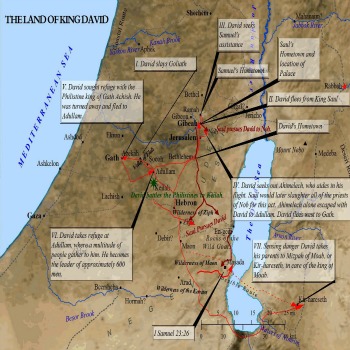
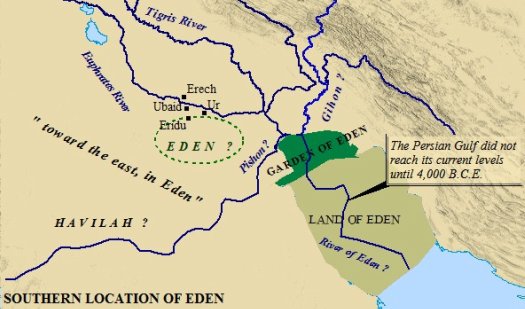
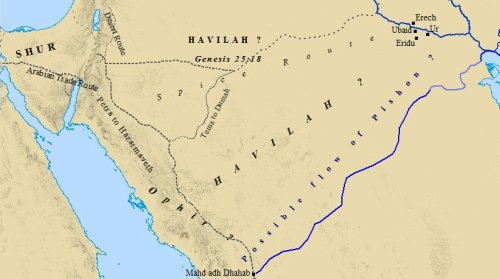

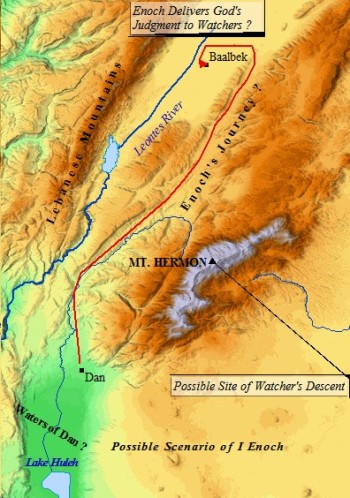
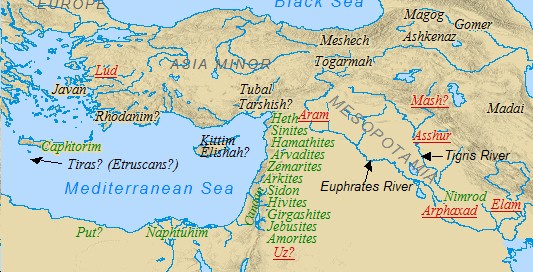
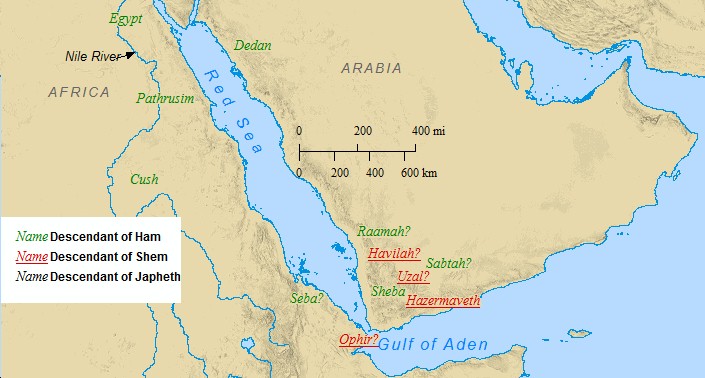
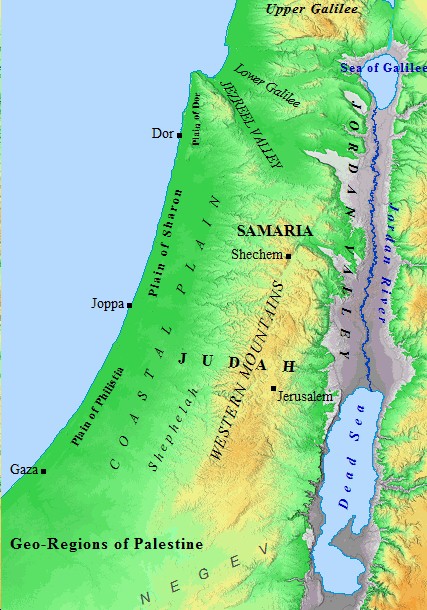
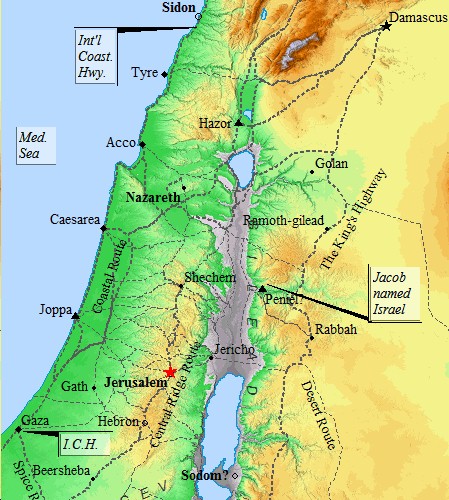
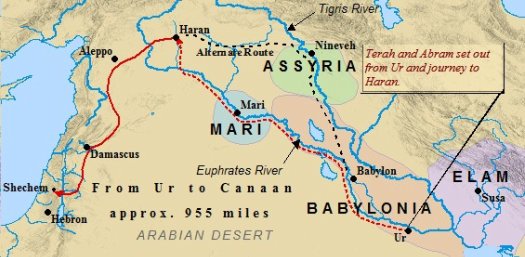
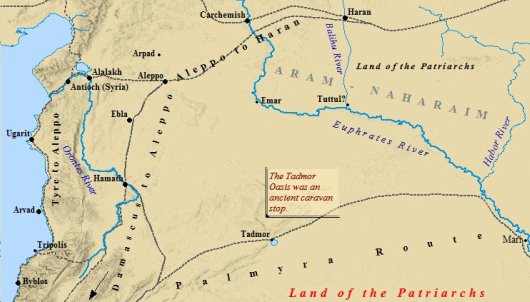
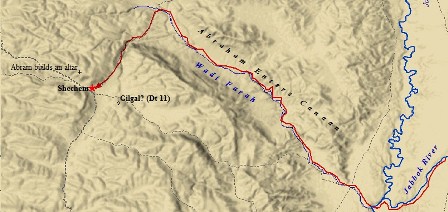
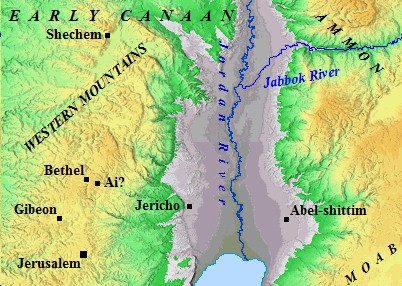
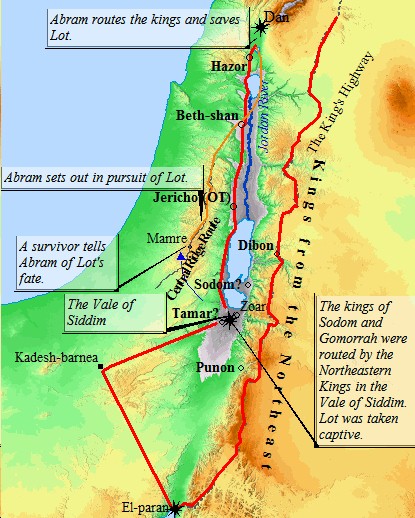
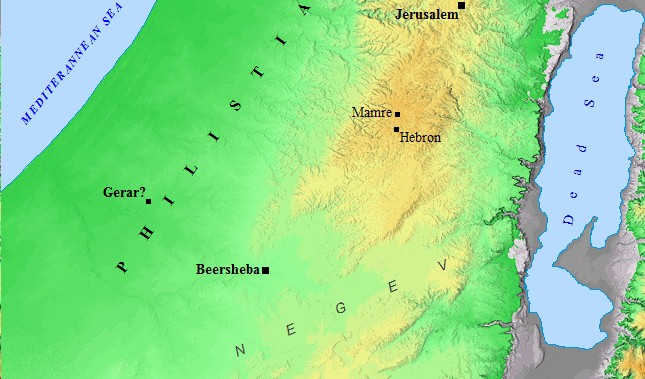
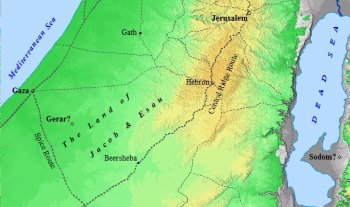
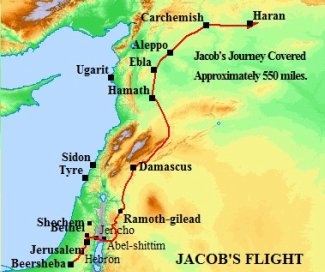
No comments:
Post a Comment